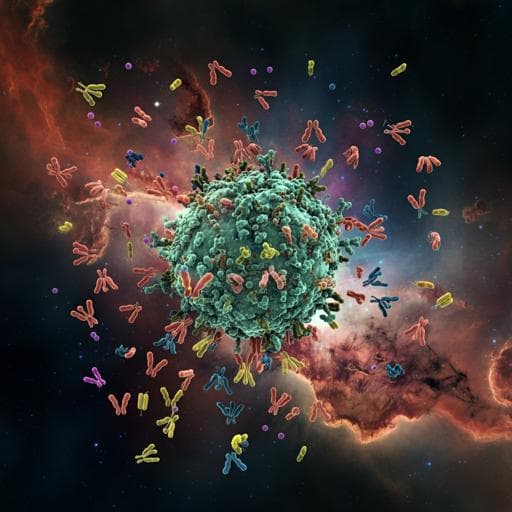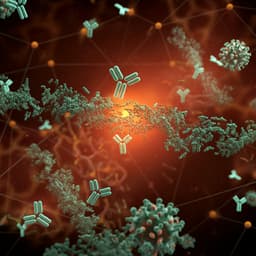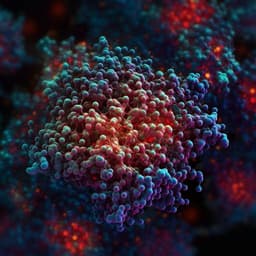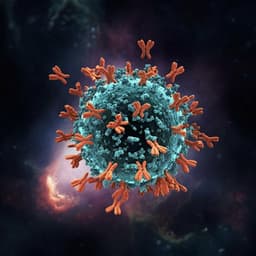
Medicine and Health
A Gamma-adapted subunit vaccine induces broadly neutralizing antibodies against SARS-CoV-2 variants and protects mice from infection
L. M. Coria, J. M. Rodriguez, et al.
A groundbreaking study by Lorena M. Coria and colleagues reveals that a Gamma SARS-CoV-2 variant RBD vaccine adjuvanted with Alum is significantly more immunogenic than traditional options. This vaccine not only induces broader neutralizing antibodies but also enhances T cell responses, offering robust protection against various SARS-CoV-2 challenges. Its performance as a heterologous booster holds promise for future vaccinations.
~3 min • Beginner • English
Introduction
Severe Acute Respiratory Syndrome Coronavirus 2 (SARS-CoV-2) has infected over 777 million people worldwide and resulted in more than 7 million deaths. The vaccines authorized for emergency use or fully approved are safe and highly effective against severe disease. However, vaccine-induced protection against symptomatic SARS-CoV-2 infection wanes over time. Additionally, as the COVID-19 pandemic progressed several variants of concern (VOCs) emerged, including Beta, Delta, Gamma, Omicron (BA.1) and its subvariants (BA.2.1, BA.4/BA.5, BQ.1 and XBB and descendants). Omicron lineages have been reported to be more resistant to neutralization, motivating the development of variant-adapted vaccines. This study presents a recombinant receptor-binding domain (RBD) subunit vaccine adapted to the Gamma variant and adjuvanted with Alum, aiming to induce broad and durable immunity across VOCs and protect against infection in mouse models.
Literature Review
Prior studies and clinical experience indicate waning immunity after primary vaccination regimens and reduced neutralization of Omicron subvariants by antibodies elicited against ancestral strains. Variant-adapted vaccines (e.g., Beta-derived formulations) have shown enhanced breadth of neutralization and immunogenicity in preclinical models and clinical trials, including increased cross-reactivity across multiple VOCs. RBD-dimer subunit vaccines (e.g., ZF2001) demonstrated safety, immunogenicity, and protective efficacy in humans and animal models, with structural arrangements that enhance immunogenicity relative to monomers. Heterologous booster strategies generally outperform homologous boosting for several vaccine platforms, improving effectiveness across outcomes. These data provide the rationale for designing and testing a Gamma-adapted RBD-dimer vaccine to improve breadth and durability of protection against evolving SARS-CoV-2 variants.
Methodology
Antigen design and production: RBD antigens were engineered as single-chain homodimers comprising Spike residues 319–537 from the ancestral (Wuhan-Hu-1) or Gamma variant (mutations K417, E484K, N501Y). Constructs were codon-optimized for CHO-S expression, cloned into pJCUMCS-4 (CMV promoter), transfected into CHO-S cells, and selected with G418. High-productivity clones were scaled in perfusion bioreactors. Purification used mixed-mode affinity capture followed by two ion-exchange steps and tangential flow filtration. Quality controls included SDS-PAGE, Western blot, endotoxin, host-cell proteins, and residual DNA. ACE2 binding was assessed via ELISA; both Ancestral and Gamma RBDs bound hACE2 with comparable affinity, slightly higher for Gamma.
Formulation: Antigens were adsorbed to aluminum hydroxide (Alum) with free antigen <10% and endotoxin <4 EU/mL.
Animals and immunizations: Female BALB/c and C57BL/6 mice (8 weeks) received i.m. injections on days 0 and 14 of Gamma RBD + Alum, Ancestral RBD + Alum, or placebo (Alum). Additional groups included ancestral Spike + Alum. For booster studies, mice were primed with two doses of one platform (BNT162b2 mRNA, BBIBP-CorV inactivated, ChAdOx1-S adenoviral, or Gamma RBD subunit); at ~day 99 they received homologous or heterologous (Gamma RBD) boosters.
Humoral assays: RBD-specific IgG measured by ELISA against Ancestral, Gamma, and Omicron BA.4/5 RBDs at serial time points. Neutralization used live-virus assays reporting NT50 against Ancestral and VOCs (Alpha, Beta, Gamma, Delta, Omicron BA.1/BA.5). Antigenic cartography (Racmacs R package) visualized antigenic distances.
B cell and Tfh analyses: Flow cytometry quantified splenic B cell subsets (RBD+ B cells, RBD+ IgG+ B cells, RBD+ plasmablasts), germinal center B cells, and T follicular helper (CD4+ CXCR5+ PD-1+). Epitope prediction: IEDB and Vaxjen were used for B cell linear epitope identification; NetMHCpan/IEDB MHCpan predicted CD4/CD8 T cell epitopes in Ancestral vs Gamma RBD sequences.
Cellular immunity: Splenocytes were re-stimulated with RBD proteins/peptides; intracellular cytokine staining quantified IFN-γ, TNF-α, IL-2 production in CD4+ and CD8+ T cells; multiplex cytokine profiling assessed Th1/Th2/Th17/Th9/Th22 cytokines in supernatants.
Challenge studies: K18-hACE2 transgenic mice were vaccinated (placebo, Gamma RBD + Alum, Ancestral RBD + Alum, or bivalent BNT162b2) and challenged intranasally with Omicron BA.5 (1×10^4 PFU) or, in a separate setting, WA1/2020 (10^5 PFU). Viral RNA in lung homogenates was quantified by RT-qPCR (WHO RdRp target). Histopathology (H&E) of lungs evaluated edema, hemorrhage, type II pneumocyte hyperplasia, and leukocyte infiltration with scored severity.
Statistics: GraphPad Prism; two-group comparisons by unpaired t-test or two-sided Mann–Whitney U; multi-group by one-way ANOVA/Kruskal–Wallis with post-tests; p<0.05 considered significant.
Key Findings
- Immunogenicity: Both Ancestral and Gamma RBD + Alum induced high RBD-specific IgG, but Gamma RBD elicited significantly higher IgG titers against Ancestral, Gamma, and Omicron BA.4/5 RBDs by day 28 and 42.
- Neutralization breadth: Gamma RBD vaccination produced higher and broader neutralizing activity than Ancestral RBD across VOCs. Neutralization against Ancestral was higher with Ancestral RBD early, but Gamma RBD achieved broader cross-variant neutralization, including Omicron BA.1 and BA.5.
- B cell responses: Gamma RBD increased frequencies of RBD+ B cells and plasmablasts, and enhanced germinal center B cells relative to Ancestral RBD, supporting affinity maturation and durability.
- Epitope mapping: Immunoinformatics predicted higher antigenicity for a shared linear B cell epitope that includes N501Y in Gamma RBD and identified a novel MHC II–restricted T cell epitope (I-A haplotype) generated by N501Y not present in Ancestral RBD.
- T cell responses: Gamma RBD induced robust CD4+ T cell responses (IFN-γ+, TNF-α+, IL-2+) exceeding those from Ancestral RBD; CD8+ responses were similar between vaccines. Polyfunctional CD4+ T cells (IFN-γ+ TNF-α+) predominated with Gamma RBD. Multiplex cytokines indicated mixed Th1/Th2 responses and induction of Th17/Th9/Th22 cytokines with Gamma RBD.
- Protection in vivo: In K18-hACE2 mice challenged with Omicron BA.5, Gamma RBD + Alum and bivalent mRNA-vaccinated groups showed reduced lung viral RNA and improved lung histopathology versus placebo; vaccinated mice had reduced edema and inflammation and no pneumocyte hyperplasia.
- Durability: Gamma RBD elicited long-lasting antibodies with neutralizing activity detectable up to at least 253 days post-immunization; bone marrow long-lived plasma cells were observed after Gamma vaccination.
- Booster performance: As heterologous boosters, Gamma RBD induced equal or superior increases in binding and neutralizing titers compared with homologous boosts across platforms:
• BBIBP-CorV-primed: RBD IgG fold-increase heterologous vs homologous ≈ 18.4 vs 16.1.
• ChAdOx1-S–primed: 13.9 vs 6.5 (heterologous vs homologous).
• mRNA-primed (BNT162b2): similar binding IgG increase (≈6× heterologous vs 4× homologous) with significantly higher neutralization against Ancestral, Gamma, and Omicron BA.1/BA.5 after heterologous Gamma RBD boost.
- Antigenic cartography showed broader neutralization landscapes for Gamma RBD–vaccinated sera than for Ancestral RBD.
Discussion
The study addresses the need for broad-spectrum COVID-19 vaccines in the face of immune-evasive variants by adapting a subunit RBD-dimer vaccine to the Gamma variant. Incorporating Gamma-defining substitutions (K417, E484K, N501Y) enhanced B cell epitope antigenicity and introduced favorable T cell epitopes, leading to increased germinal center reactions, higher frequencies of antigen-specific B cells, and polyfunctional Th1-skewed CD4+ responses. These immunologic advantages translated into broader neutralization across VOCs, including Omicron subvariants, and conferred protection in a stringent K18-hACE2 mouse challenge model with Omicron BA.5, reducing lung viral loads and pathology. As a heterologous booster, the Gamma-adapted vaccine augmented both binding and neutralizing antibodies beyond homologous regimens for adenoviral and inactivated platforms and improved cross-neutralization in mRNA-primed mice. Collectively, the data support Gamma RBD as a versatile, broad-spectrum immunogen suitable for primary vaccination and boosting to counter ongoing viral evolution.
Conclusion
A Gamma-variant–adapted RBD-dimer subunit vaccine formulated with Alum is highly immunogenic, induces broad and durable neutralizing antibody responses, elicits robust polyfunctional CD4+ T cell responses, and protects mice from Ancestral and Omicron BA.5 SARS-CoV-2 challenge. As a heterologous booster, it enhances binding and neutralizing titers across vaccine platforms and improves cross-neutralization against Omicron subvariants. The vaccine is manufacturable under GMP, stable at 2–8 °C, and has advanced through Phase 2/3 clinical trials (Ancovir/Gamma-RBD/BA.5) in Argentina. Future work should include comprehensive clinical efficacy evaluations against current and emerging variants (e.g., XBB and descendants), optimization of dosing/boost intervals, expansion of antigenic cartography with contemporary lineages, and studies of long-term cellular memory and correlates of protection.
Limitations
- Preclinical data are primarily from mouse models (BALB/c, C57BL/6, K18-hACE2), which may not fully predict human immunogenicity and efficacy.
- Challenge experiments focused on selected strains (Omicron BA.5 and WA1/2020); breadth against newer lineages was inferred from neutralization rather than in vivo protection.
- Immunoinformatics predictions of epitopes were not exhaustively validated experimentally for all candidates.
- Comparisons to other platforms and boosters used specific doses and schedules; real-world performance can vary with different regimens and intervals.
- Use of Alum as the sole adjuvant may limit Th1 polarization relative to other adjuvants; alternative adjuvants were not systematically compared in this study.
Related Publications
Explore these studies to deepen your understanding of the subject.







